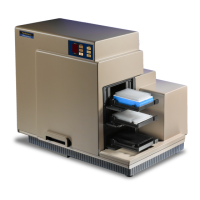Description
0112-0127 B 13
System Overview
The FlexStation 3 Benchtop Multi-Mode Microplate Reader is a
monochromator-based microplate reader that has 6-well, 12-well, 24-
well, 48-well, 96-well, and 384-well microplate reading capability for
absorbance, fluorescence intensity, fluorescence polarization, time-
resolved fluorescence, and luminescence. When using the integrated
pipettor, the instrument offers 96-well and 384-well microplate-to-
microplate fluid transfer, 8 or 16 wells at a time.
The top portion of the instrument, the fluidics module, uses an 8-channel
or 16-channel pipettor, to expand assay flexibility by transferring
reagents from a 96-well or 384-well source plate to the assay plate.
When transferring reagents from distinct wells of a microplate, users can
define individual reagents or concentrations to be delivered in each well
during their assay. This direct transfer allows more assay conditions to be
explored in a single microplate, reducing reagent consumption as well as
making the system more amenable to both agonist and antagonist assay
formats. In addition, kinetic cell-based assay throughput (for example,
calcium mobilization) is increased when 8 or 16 wells of a microplate are
analyzed in conjunction rather than individually.
Integrated pipetting provides flexibility, and also offers users parameters
to optimize assay robustness. Trituration, mixing via aspiration and
dispense of the pipettor, encourages mixing to either resuspend source
plate compounds or spontaneously mix reagents to promote a rapid
response with minimal assay variability. Dispense parameters can also be
optimized for each experiment to accommodate cells with different
adherence characteristics to prevent cell dislodging. Furthermore, the
integrated fluidics platform uses disposable pipette tips to minimize
reagent cross contamination between wells or experiments.
The fluidics module interfaces with the lower reading chamber which
encloses a high-powered Xenon flash lamp as the light source. Sensitivity
or read-speed can be optimized by varying the number of lamp flashes
per read.
The two holographic diffraction grating monochromators allow selection
of any wavelength between 200 nm and 1000 nm in absorbance; 250 nm
and 850 nm in fluorescence intensity, time-resolved fluorescence (TRF),
or luminescence; and 400 nm and 750 nm for readings in fluorescence
polarization. Excitation and emission wavelengths are optimized using
the mirrored optics to focus light into the sample volume, and cutoff
filters to reduce stray light and minimize background interference.
FlexStation_manual.book Page 13 Tuesday, June 25, 2013 10:22 AM

